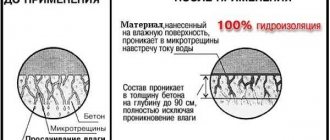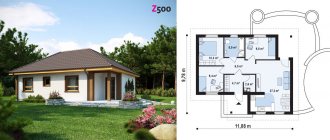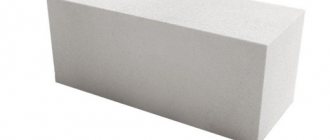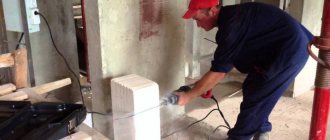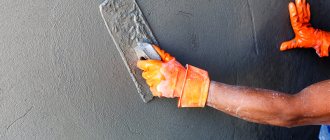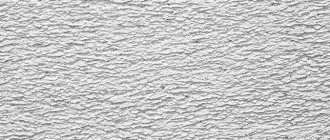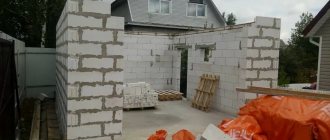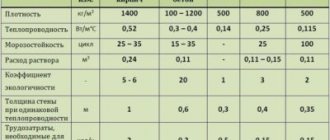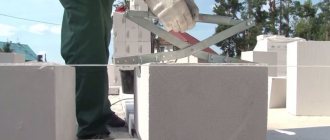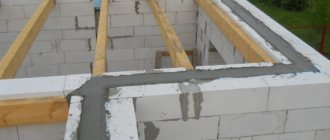Any concrete that does not contain special water-repellent additives absorbs moisture well. Aerated concrete has the highest ability to absorb water, since its body is not only full of pores, but these pores also have an open structure. This makes the material “breathable” (it allows vapors to pass through well), but creates certain problems when applying adhesives and plasters. Hydrophobization of aerated concrete is an integral part of such construction; this process will be discussed in more detail in this article.
Types of hydro- and vapor barriers for walls
Waterproofing materials for aerated block walls can be different:
- coating;
- pasting;
- membrane
Let's look at each type in detail.
Coating
This type of insulation is a mastic based on bitumen or with a high-polymer composition, which is used only for external use. The former differ in the principle of application: cold application with layer-by-layer application of 1 mm, the latter require pre-heating.
Advantages:
- creates a monolithic coating, without connecting seams;
- protects against moisture penetrating through capillaries;
- accessible and cheap material.
Flaws:
- Loss of elasticity at negative air temperatures;
- when deformations occur, cracks may form;
- low period of use no more than 6 years.
Popular brands:
- Bergauf, 20 kg, 750 rub.
- PALADIUM PalaRepair-501 (Waterstop), 20 kg, 700 rub.
- Aquastop W12 PERFEKTA, 20 kg, 900 rub.
- Cleber B11, 25 kg, 750 rub.
- Ivsil Vodostop, 20 kg, 550 rub.
Pasting
Rolled bitumen or polymer building materials are classified as adhesive waterproofing. The simplest method of application is by fusing with a special gas torch. Polymer waterproofing, attached to mastic. Self-adhesive film options are relevant for low-rise construction.
Positive aspects of adhesive insulation:
- stable layer thickness;
- high chemical protection;
- possibility of mounting in several layers up to 5 mm;
- versatility of application to any type of wall.
Flaws:
it is necessary to work with the material carefully so as not to overtighten or tear it; careful preparation of the surface is required before installation; there are restrictions on air temperature during work not lower than + 10 C; the need for careful connection of the joints of the insulator; difficult to apply on complex walls and corners.
The most popular types of roll type:
- A budget option:
- Stekloizol HPP 3.0 10x1m, 580 rub.;
- glassine P-350, 20x1 m, 250 rub.;
- roofing material RKP-350.15 m, 450 rub.
- Standard class:
- bicroelast 10x1 m, 1200 rub.;
- bipole 15x1 m, 1700 rub.;
- linochrome 15x1 m, 1300 rub.
- Super class:
- ecoflex 10x1 m, 1700 rub.;
- uniflex, 10x1 m, 1800 rub.;
- technoelast, 10x1 m, 2500 rub.
Membrane
Polymer membranes are high-tech waterproofing materials with a wide range of applications. They are produced on the basis of high-quality plasticized PVC with the addition of innovative plasticizers and additives.
The most popular waterproofing membranes:
- superdiffusion membrane Juta Yutavek 115 red, 1.5x50 m, 5500 rub./piece;
- profiled membrane TechnoNIKOL Planter Eco, 2x10 m 140 RUR/m2.
Vapor barriers have a multilayer porous structure. The outer side is rough, and the back is smooth. Installation is carried out with the smooth side facing the insulation. The rough one turns inwards towards the wall,
Popular vapor barriers:
- Yutafol - 1.5x 50 m, 1850 rub.;
- Yutavek - 1.5x 50 m, 4000 rub.;
- Foil Izospan - 70 m2, 2080 rub.;
- Izover - 70 m2, 1250 rubles;
- Tyvek Solid - 75 m2, 7500 rub.
What does the concept mean?
A crack in the wall is not a good thing for a house that was recently built. It so happens that over time, houses can shrink, resulting in defects appearing in the stone masonry.
Aerated concrete is a lightweight and convenient material with regular geometry, which is why it is often used in construction. As the wall is being built, difficulties may arise that need to be corrected immediately. If this is not done and the masonry is carried out in violation of the technology, then cracks will form on the wall.
- microcracks;
- vertical;
- horizontal.
Often home owners make redevelopment without consulting an architect:
- move walls;
- new partitions are being erected;
- use other finishing materials.
All of these act to increase the weight of the structure. As a result, the formation of defects cannot be avoided.
Vertical defects are located from top to bottom, horizontal defects are located from left to right or vice versa. Microcracks are often invisible, but if they are not detected in time, they gradually increase in size and cause more problems.
What influences the choice of facade paint for foam blocks
When choosing paints and varnishes, it is necessary to take into account the characteristics of the blocks and the quality of the masonry.
If you liked the way your neighbor's house looked after painting, it doesn't mean your house will look the same after applying the same paint. It has been repeatedly tested: the same façade paint for foam blocks will look different on different surfaces .
When painting foam concrete walls, consider the following factors.
- If the technology of jointing masonry was used, it is worth choosing smooth silicate, silicone and combined compositions on a water-based emulsion. Moreover, this option is suitable for blocks with both straight and beveled edges at an angle of 45°. Embroidered seams visually fade into the background, the painted surface acquires volume and relief. Please note that the use of conventional structural paints and varnishes will remove this effect, which is why the appearance of the wall will look less advantageous.
- For work on plaster or simply smooth wall surfaces, structural paints with coarse fillers are more suitable. In this case, the visual volume of the coating is obtained through multi-layer painting, as a result the surface will look more impressive.
The choice of paints is huge, and you can experiment with other materials, but professionals, in most cases, take exactly this approach to choosing facade paint for foam blocks.
Protecting walls with special plaster
In historical premises, the walls are made of brick and often have high humidity. To effectively remove this moisture, sanitizing plaster is used. This is a special plaster composition with a large-porous structure that effectively sucks moisture out of the wall and actively evaporates it without visible traces. Apply indoors in a layer of 2 cm.
This type of plasters can be painted in any color, but it is necessary to use vapor-permeable paint for mineral substrates.
Selection of materials
- The coating composition is sold in all construction stores; each manufacturer offers its products upon purchase, which should be ensured that there are documents confirming the quality and origin of the material.
- To treat wooden surfaces, use a waterproofing compound with additives that prevent the development of fungi and mold. Surface treatment should be carried out immediately after completion of construction. If mold appears on the wall, disinfect the area, clean it and treat it with an antiseptic as soon as possible.
- Before gluing the rolled material, a brick or concrete wall is treated with a primer to increase adhesion.
- When choosing any material, it is better to give preference to well-known brands, even if the price is slightly higher than analogues.
Why protection is needed
The stone is able to “breathe”, while being distinguished by high thermal insulation and sound insulation capabilities. Absorption of water in significant quantities causes deviations in these indicators towards their deterioration. To exclude such a manifestation, it is necessary to waterproof the aerated concrete.
Note that the blocks are actively saturated with moisture during rain, wet snow, and in the spring season. If their surface is not protected, the material will absorb up to thirty-five percent of its total weight of water. A room built from such material will be damp and cool. In addition, wet blocks may crack in severe frost.
Protecting aerated concrete from moisture
The common belief that aerated concrete absorbs some of the water like a sponge is due to its porous structure, which is formed during the production process. At the same time, aerated concrete holds the accumulated volume of water within itself.
The insignificant level of water absorption of aerated concrete is due to the fact that the pores in this material are not only closed, but also open. Cellular aerated concrete absorbs moisture by 6-8%, as it has the property of hygroscopicity. Considering this property of blocks, it is necessary to create additional protection from moisture. Protection of the material is provided not only for the constructed walls, but also during transportation and storage.
According to experts, in order to thoroughly destroy aerated concrete, it is necessary for the aerated concrete to remain in direct contact with water for a long time, i.e., the aerated concrete must lie in water.
The finished aerated concrete block consists of approximately 75% pores. Moreover, the largest volume is accounted for by macropores, which form rounded voids and interpore partitions.
Osnovit HC61 “AQUASCREEN” Blocking waterproofing (0.5 kg)
Price:
166.00
Founder TC 117 Coverplix Plaster-adhesive mixture (25 kg) Price:
580.00
Found AQUASCREEN HA64 Ready-made elastic waterproofing (4.5 kg) Price:
1 733.00
Found AC11 STARPLIX tile adhesive (25 kg) Price:
312.00
Osnovit AC12 T MASTPLIX Leveling adhesive for ceramic tiles and porcelain stoneware (25 kg) Price:
450.00
The operational humidity of aerated concrete products is 4–5%. At the same time, the critical humidity for the material, which entails its destruction, for aerated concrete with a density of 400 kg/m³ is 45–50%. Similar indicators for aerated concrete with a density of 500 kg/m³ are 40%.
Thanks to its porous structure, the material “breathes” and, accordingly, has high thermal insulation and sound insulation properties. Absorption of large amounts of moisture leads to a change in these properties for the worse. To ensure that aerated concrete does not absorb moisture, additional processing is carried out.
It actively absorbs moisture from the environment during rain, sleet, and also in spring when the snow melts. If you do not create protection, aerated concrete can absorb up to 35% of moisture relative to its weight. This percentage of moisture sharply reduces thermal resistance, and the rooms become damp and cold. Aerated concrete can crack in winter if the premises are not warmed up in the fall and the material has absorbed a large amount of moisture.
The humidity of aerated concrete used to construct the wall of a building depends on the number of seasons of operation of the house, on the design of the wall and sorption capacity. For example, the moisture content of the aerated concrete wall of a country house, which is not used for residential purposes during the cold season, does not play any important role. If the mineral material aerated concrete is protected from precipitation by a reliable roof, then in this mode of use of the building it will always be unharmed.
Moisture can enter the room from below from a poor-quality foundation or from the junction of walls with the ground surface; outside, with changing seasons, precipitation; from the inside in case of improper operation of the air conditioning system, flooding.
According to the manufacturers, a certain amount of water can penetrate shallowly into the material, however, it is the capillary-porous structure of the block that allows it to release moisture back quite easily and quickly, i.e., the liquid does not linger for a long time in the structure of wetted aerated concrete.
Aerated concrete easily releases the accumulated part of the water outside; when the air in the room becomes too dry, a wall made of this material will provide humidification.
The amount of water that penetrates into aerated concrete primarily worsens its thermal insulation properties. The higher the water absorption, the lower the actual thermal insulation properties of the material.
Aerated concrete walls, when saturated with water, create additional weight loads in the structures in which they are used. Accordingly, the higher the water absorption of aerated concrete, the greater the risk of an emergency.
The sphere of water itself is a destructive factor. The constant presence of water in aerated concrete can lead, at a minimum, to a decrease in strength.
Currently, two methods of protecting aerated concrete from water have found the greatest practical application: waterproofing and hydrophobization.
Water repellents are compositions that are supplied in the form of concentrates or ready-to-use solutions, aqueous or in organic solvents. They do not create a surface film, but form a water-repellent (hydrophobic) layer up to several millimeters deep. The vapor permeability of the treated surface is almost not reduced, i.e. some of the water evaporates but does not get inside. The surface treated with a water-repellent agent, as a rule, does not change color. A hydrophobic coating significantly increases the frost resistance of any material.
These properties make it possible to use water repellents on silicate and ceramic bricks, concrete and aerated concrete, limestone, travertine, shell rock, granite, marble and even paving slabs.
The water-repellent effect is due to the penetration of the water repellent into aerated concrete to a depth of 5 to 50 mm, depending on its density and humidity. The water repellent is fixed after 12–24 hours. At the same time, crystals form in the capillaries of the material, which prevent water from penetrating into the aerated concrete. But this does not prevent air from entering.
As for waterproofing, experts note: the construction of a wall helps to largely eliminate the negative impact of water on aerated concrete. Ideally, the “pie” of the wall structure should be such that the outer layer is significantly more permeable to vapors than the inner one. This will not only effectively remove some of the water from the premises, but also prevent water from entering the house from the street. For example, Indastro Renoart RSi240 will help solve this problem.
To prevent blocks from absorbing moisture, various methods of protection are used. Osnovit SSL15 Safescreen insulation with antiseptic properties also performed well.
Treatment of the inner surface of the walls with a deep penetration primer (Ecorum acrylic primer) followed by treatment with putty for interior work. This creates a vapor barrier. To create such a barrier, you cannot use traditional plaster without treating it with a primer and gluing it to the surface of the wallpaper. When using traditional plaster, the aerated concrete becomes damp from moisture from inside the room. The plaster is cracking and peeling. The outer side of the wall is treated with gypsum plaster; cement-sand plaster is not suitable, as it peels off. Treatment with gypsum plaster is carried out once every 2-3 years.
Using decorative materials to decorate the outside of walls, such as tiles, stone, and so on. The decoration will protect the layer of plaster on the surface of the aerated concrete. Large selection of decorative coatings here.
The outer side is lined with brick. Pick up a brick. Since the cement-sand mortar allows steam to pass well between the brickwork and the aerated concrete wall, an air gap is left. The width of the gap is approximately half a brick. In construction in this way, one small problem arises: how to fix the facade wall if it is being built with a gap. The problem is solved using anchor elements, which are installed every 5 rows of laid brick. It is not recommended to use ordinary reinforcement or steel angles as anchors, as these elements are susceptible to corrosion. Over time, there will be no rigid connection between the load-bearing wall and the facade. The front wall will collapse. Fiberglass or stainless steel, popular on the building materials market, is used as anchors.
Finishing the facade with siding. The method is much worse than brickwork; it is not recommended to use it, since there are a lot of hidden problems after the work is completed. Of course, the finishing may look beautiful and the price is several times lower, but the durability of a building made of aerated concrete will decrease.
The use of reinforced concrete sandwich panels, which are based on shipbuilding concrete with a water resistance value of W.
Along with the finishing of the internal and external walls made of aerated concrete, work is carried out to waterproof the foundation, since moisture can penetrate through an improperly constructed foundation. To do this, when building walls, aerated concrete blocks are laid above ground level from 30 to 50 cm.
With high-quality installation of window openings, decorative ledges and roofs with drainage systems, as well as high-quality waterproofing of the base, a house made of aerated concrete can last for decades without the occurrence of any structural defects.
When carrying out construction work, do not leave aerated concrete in the open air, as when it rains, moisture is absorbed very quickly and its properties deteriorate. It is not recommended to unpack the aerated concrete completely.
It is not recommended to build structures made of aerated concrete from November to March. During this same period, it is not advisable to plaster the wall surfaces. Excessive moisture will worsen the properties of the block, and when the plaster dries in a hotter, drier period, it will peel off and crumble. In this case, all plastering work must be repeated.
Foam concrete and aerated concrete: what is the difference?
Both materials are classified as lightweight cellular concrete. The difference lies in the manufacturing method and composition:
- foam concrete is a naturally hardened mixture of sand, water and cement. Cells (bubbles) are formed in it when foaming agents are added to the composition;
- aerated concrete has the same composition, but it additionally includes a siliceous binder component. Pores in the blocks are formed after the introduction of aluminum powder into the mixture, which, by entering into a chemical reaction with calcium oxide hydrate, promotes the release of hydrogen. Blocks harden at high humidity and temperature.
Foam concrete and aerated concrete are the same in density, but different in strength. With a density of 500 kg/m³, foam concrete will withstand a load of 9 kg per 1 cm², aerated concrete - 32 kg per 1 cm².
Since the sizes of pores (cells) and their distribution in materials are not the same, the thermal conductivity and moisture permeability of foam and aerated concrete are different:
- under humidity conditions of 6% D500, foam concrete shows a thermal conductivity coefficient of 0.13-0.16;
- aerated concrete under the same conditions - 0.116;
- the pores in foam concrete are unevenly distributed, isolated from each other and unequal in size, so they slowly absorb moisture;
Water is the basis of life
As you know, moisture is not only the basis of the human body and the main component of our planet. Water is one of the main liquefying components in the formulation of the vast majority of ready-mixed concrete of various structures and purposes - from heavy to foamed. But at the same time, for a number of finished products, due to some of their features, water brings absolute death.
Destroyed masonry is one of the most unpleasant surprises
The foam block in its body has an array of connected micropores, which have an intensive and developed network of partitions, localizing each pore as, albeit small, but a separate element.
It is the strength and resistance to external influences of an individual partition that determines the strength and stability of the finished product as a whole. This is also true for the moisture resistance of the block.
Despite the specific structure of the mass, foam concrete is easily processed, maintaining sufficient strength indicators
The foam block production technology involves introducing a foaming agent into the sand-cement mash, which is mechanically distributed throughout the entire mass of future foam concrete. The foaming agent can be of both organic and inorganic origin.
Porous structure is the basis of the positive qualities of concrete
One of the luminaries in the production of classic cellular concrete of various natures is rightfully the Italians. It is the use of Italian protein organic foaming agents that is presented by domestic producers of foam concrete in their advertising brochures as one of the decisive arguments for their quality.
Note: But don’t delude yourself. Any production is, first of all, a system of technological measures, and the use of only one or a few high-quality components does not guarantee a high-quality final product.
Alignment to the West
During the era of widespread industrialization in the Soviet Union, a group of lathes appeared under the DiP brand: DiP-200, DiP-300, DiP-500. The abbreviation DiP meant the banal Let's Catch Up and Overtake. The Soviet Union has long since sunk into oblivion, the vast majority of D&Ps ended their journey at scrap metal depots, and we are still catching up and catching up with world progress.
Suffice it to say that the basic model of European equipment for the production of cellular concrete is digitized inside and out, and its technological controller is capable of simultaneously reading, processing and adjusting at least 12 parameters; similar technological lines of the premium sector simultaneously provide up to 43 /forty-three/ input and current data.
Computerized process control systems - the realities of today
In comparison, the controllers of the same Chinese systems, in the overwhelming majority, only imitate the reading, processing and adjustment of basic technological parameters, such as viscosity, polyzonal mash temperature, alkalization indices, and so on. Thus, given the complexity and responsibility of the technological process for producing foam concrete, it is impossible to obtain a high-quality product without high-quality and expensive equipment.
In many ways, modern equipment is the key to quality
Formed in violation of production technological conditions, pores and their partitions are, in principle, unable to sufficiently resist the destructive effects of moisture, and destruction of the foam block mass is possible even when high-quality waterproofing work is carried out.
Neglect in choosing quality materials can easily turn a building into an ancient Roman ruin
Rule 1. From here follows the first and, perhaps, the main rule when choosing foam blocks and drawing up measures for their waterproofing. Choose the material carefully, and take an equally careful look at the manufacturer. Otherwise, the waterproofing carried out will be a waste of money and time.
Insulation of a foam block house with ecowool on the outside
Foam concrete blocks themselves have good heat retention properties; moreover, the material is almost not saturated with moisture and does not allow street noise to pass through. Additional thermal insulation of foam concrete makes it possible to reduce the thickness of load-bearing walls, which saves money spent on construction.
Thermal insulation of foam concrete blocks can be carried out with cellulose ecowool, which provides significantly better heat and sound insulation than slab or roll insulation such as foam plastic or stone wool. Ecowool is able to absorb without damage and release back up to 30% of the moisture from the volume.
The positive properties of insulation include environmental cleanliness, fire safety, fire resistance and the impossibility of reproduction of insects, rodents or harmful bacteria and fungi in its thickness.
It is also important that a layer of ecowool 10-20 centimeters thick is sufficient to protect walls built from blocks in one row. Moreover, cellulose wool extends the service life of foam blocks, since it actively prevents the penetration of dampness and smoothes out temperature fluctuations outside the house.
The process of external insulation of houses with ecowool is described in detail here.
Using ecowool as a heat insulator allows you to create a comprehensive system of strong load-bearing foam concrete walls and reliable protection from low temperatures and humid air, which ecowool provides.
Features of the material
Aerated concrete is one of the representatives of the cellular concrete family. It has characteristics that differ significantly from the parameters of dense grades of concrete:
- low thermal conductivity;
- light weight;
- relatively low strength and density;
- hygroscopicity.
The properties of aerated concrete are very contradictory - on the one hand, the material is light and retains thermal energy well. These are undeniable advantages, allowing you to significantly reduce the power (and therefore the cost) of the foundation, and significant long-term savings on heating. However, the negative properties of the material limit its capabilities and make it dependent on external conditions. The low strength of aerated concrete does not allow building houses higher than 3 floors (this applies to the most common and popular brands of aerated concrete D500, D600, etc.). The hygroscopicity of the material puts forward serious demands on the exterior finishing and conditions for laying gas blocks.
All qualities of the material arise due to the porous structure. Any properties of aerated concrete are a consequence of the presence of small air bubbles evenly distributed throughout the entire volume of aerated concrete or gas silicate blocks. If we limit ourselves only to hygroscopicity, we can find a lot of contradictory data, often having nothing to do with reality. Aerated concrete often shows higher abilities than is commonly believed. Most likely, this is due to the large number of manufacturers producing material that does not meet technical standards. Therefore, you need to choose products from trusted and reliable companies (for example, YTONG).
Materials for waterproofing plastic windows
The choice of building materials is carried out in accordance with the working conditions. To solve different problems, building materials are different.
| Task | Materials |
| First window installation | Select foam and hydro-protective tape |
| Repair work of adjacent areas | One tape is enough |
| Frame repairs | Silicone sealants are used |
Waterproofing tape for window
There are 4 types of tapes:
- Steam and moisture resistant with adhesive. A regular tape is distinguished by its ability to keep out both drizzle and air. It is reasonable not to use it for buildings made of aerated and foam concrete. When there are voids in the joint seam, a fungus “starts”, destroying the stone.
- Insulated. It has a coating in the form of a reflective layer. It keeps the cold out and keeps the room warm. Often used in frosty climates.
- Pre-compressed. Retains water but conducts air. Suitable for use in buildings made of foam concrete. In cold areas it can be used in combination with a diffuse outer tape.
- Tapes for outdoor use. Resistant to weather extremes (heat, snow, rain). They limit the passage of moisture from the outside, and somewhat interfere with the ventilation of the seams. This is a suitable material for objects where renovations have been done.
The upper 3 formats are used only inside buildings.
Polyurethane foam
Suitable only during the installation of PVC. It foams in liquid form in the gap between the wall and the frame structure. As it dries, its pores expand and fill the voids. Secondary foaming of seams does not give the desired result. In such situations, the old foam is dismantled and a new one is then blown in.
Window sealant
This finishing building material is offered in various types:
- in dry;
- in a tube;
- like paste;
- in a bucket in the form of a ready-made mixture.
The tube and pastes are suitable for coating small seams and are produced in small volumes. Ready-made materials are used if complete installation is carried out at one time.
Liquid sealant for windows
Liquid mastic is suitable for sealing seams and for frame repairs (when the rubber of the glass unit is worn out or has mechanical damage).
Protection of plaster facades
Plaster facades are also susceptible to destruction from moisture getting into them, and therefore waterproofing of a plaster facade on any base will be required.
To protect them, organosilicon additives are used; they protect against moisture and increase the drying speed of the plaster finish by 2 times. The process of their preparation is normal and does not involve any special technological processes.
The solution can be prepared both at the work site and at units specially designed for this, but the solution must be made in a mortar mixer.
Application to walls occurs in the usual way, using a brush or spray gun. After treatment with hydrophobic liquids, the facade will be protected from moisture and dirt, which can ruin its appearance, especially if the facade is bright in color.
Which primer to choose
The primer for aerated concrete consists of polymers; it is perfect for interior work, but it can also be used outside. The main purpose of such soil is to reduce adsorption properties. Special additional additives have the ability to prevent the formation of fungus, mold or moss.
The finished primer is vapor-permeable for a porous surface, and moisture does not accumulate. In addition, it is resistant to atmospheric agents and tends to repel moisture and dirt.
External wall waterproofing
In order to protect the walls from the effects of various weather factors, it is necessary to provide them with waterproofing of the brick wall from the outside as follows:
- It is necessary to remove dirt and remnants of previous coatings from the wall (if any). There should be no unevenness, greasy spots, or traces of paint;
- if necessary, the working surface is leveled, primed and evenly dried to prevent the formation of unevenness;
- then, depending on what type of waterproofing was chosen (vertical and horizontal), the application of the material begins. In the first case, universal coatings are used for vertical insulation of walls - glued materials, and in the second - coating materials.
Pasting insulating materials:
- The wall is heated with a conventional burner until it is warm, after which special strips are glued onto it to protect the brick wall from moisture and water ingress.
- The applied strips are leveled and dried.
Plastering a brick wall:
- in this case, it is also recommended to warm up the working surface so that the material can grip better;
- then, with a regular roller or brush, begin coating the brick wall until it is completely covered;
- the material dries and hardens.
Important stages in work
Preparation of protective equipment
So, you have decided to cover the gas silicate blocks with a primer layer. And this is the right decision. First of all, you need to take care of personal safety - this is the main component of successful work:
- You must wear a hat on your head and closed shoes on your feet. It is not recommended to work in slates; it is possible that a tool may accidentally fall on your foot.
- Special glasses or a screen will perfectly protect your eyes, and rubber gloves will protect your skin from splashes.
- When working at heights, durable, proven structures should be used.
- It is not recommended to perform work if you feel unwell or feel dizzy.
Preparing tools
First you need to decide exactly how to cover the foam concrete. A roller, or maybe a spray gun, may be chosen for these purposes. It is imperative to prepare a flute and fly brush so that you can apply primer to the surface in hard-to-reach places.
You will also need:
- soil tray;
- old newspapers and rags;
- solvent (if necessary);
- metal brush;
- hammer and spatula.
Surface preparation
First, you need to clean the surface from crumbs, dust, construction debris or cement. You can use a spatula or a wire brush.
Hot steam cleaning should be used to clean oil stains and other greasy contaminants. If this is not possible, try treating the surface with a universal degreaser. Drying the surface is mandatory, otherwise the vapor-proof primer will not adhere well to the surface.
Priming process
After completing the preparatory activities, you can begin priming:
- Using a round or flat brush, work the surface in hard-to-reach areas.
- Use a spray gun or roller and cover the entire wall area. The primer should be applied evenly in one layer, being careful not to skip any areas.
- After the composition has completely dried, check whether the entire surface is saturated with the primer layer. To do this, you can use a regular flashlight or table lamp. If there are unpainted areas, the operation should be repeated.
Only careful processing of block structures will give the building additional strength and durability, and when plastering work is performed, the solution will not dry out quickly.
Manufacturers of hydrophobic impregnations
Today there is a lot to choose from. The range of brands is endless. This:
- products from Spanish manufacturers - Disom-Hidrofugo and Disom-Yesair (from SODITE), as well as MaksKLIR, MaksKLIR-D (from Drizoro);
- Italian products are widely known for the Antipluviol brand from Mapei and Hydrosil (from INDEX);
- German compounds - CERESIT (from Henkel), Asolin (from SHOM-BURG);
and others.
Aquasil
The manufacturer guarantees that the moisture absorption of aerated concrete will be reduced by 10 times, and that of gypsum-containing solutions by up to 40 times. In addition, the drug strengthens the surface of aerated blocks by a third. After treatment, other parameters also increase - frost resistance, water resistance. The solution protects against efflorescence, dust adhesion, and discoloration.
Impregnation is a concentrate in a canister. The supplier offers containers of 1 l, 5 l, 10 l. Before use, the emulsion is diluted in a ratio of 1: 10. Approximate consumption is 0.5 liters per 1 m². When surface treated, the wall acquires hydrophobic properties 2 hours after application.
The concentrate can be added to concrete and masonry mortars in an amount of 0.04% by weight of cement.
Other products of the Aquasil brand:
- AQUAFOB-E - for various materials - concrete, brick, wood, fabrics, furs;
- Aquastop - composition for the installation of cut-off waterproofing;
- Razacor is a penetrating agent, suitable for injection into the body of concrete and brick.
Tiprom
Product of JSC "SAZI". For impregnation of aerated concrete, the company produces Tiprom-U concentrate. Its parameters are similar to those of the previous drug:
- surface acting composition with a penetration depth of up to 35 mm;
- The water repellent strengthens the walls of the masonry, increases their frost resistance, and helps remove dirt;
- protects against efflorescence;
- consumption when processing porous materials – 400 ml per 1 m².
Not intended for application to dense, non-absorbent materials.
SAZI also produces the following drugs:
- "Tiprom K" - with water-repellent properties. The silicon-containing solution is intended for processing all types of building minerals, including aerated concrete, as well as for wood, chipboard, etc. Can be used as a primer for walls before painting.
- “Tiprom M” is a penetrating composition for treating walls to a depth of 5 cm. It can be used for injection of concrete and brickwork. Has a “wet brick” effect.
Penta
The product range of TM Penta consists of many types of products. Most preparations are specialized and suitable for hydrophobic treatment of a narrow range of materials. There are compositions for impregnating mineral wool, basalt and fiberglass slabs. There are – for processing woven and non-woven fabrics, for wood, leather and other types of raw materials.
The Penta-820 solution is intended for hydrophobization of aerated concrete. The material is applied to wet or dry substrates with a brush or sprayer. The composition has an antifungal, antifreeze and anti-mud effect.
Consumption of working solution – 350 ml per 1 sq. meter of aerated concrete surface. Service life more than 10 years.
What does the “pie” of insulating a wall made of aerated concrete blocks consist of?
The composition of the insulation cake for aerated concrete blocks is practically no different from other options and includes:
- wall surface
- lathing (frame)
- heat insulator
- layer of vapor-waterproofing membrane
- ventilated gap
- external cladding
The above list includes the layers from which the so-called ventilated façade is created. This is an installation technology in which an air space is created between the insulation and the sheathing, thanks to which water vapor can freely escape from the heat insulator.
This possibility must be provided without fail, since aerated concrete has high vapor permeability, and if conditions for timely release of steam are not created, the wall will begin to get wet and collapse. Moreover, the degree of vapor permeability of all subsequent layers installed on the wall should be slightly higher than that of aerated concrete, otherwise the steam will not have time to escape from the walls, will accumulate and begin to destroy the house.
This point is of great importance for the organization of insulation, since failure to comply with the requirements for decreasing the vapor permeability of materials entails very harmful consequences
Classification
Impregnation for concrete against water is classified depending on the chemical composition:
- Soils of organic origin.
- Mixtures based on inorganic modifiers.
The basis of organic primers are compositions containing:
- epoxy resins;
- polyurethane additives;
- acrylic filler.
Their effectiveness is ensured by the binding component, which fills the concrete pores and forms a moisture-resistant layer. Organic primer removes dust and increases the strength characteristics of the base.
The most effective surface waterproofing agent is considered to be a water repellent.
Properties of water repellent and antiseptic
Modern water-repellent compounds are multifunctional. They turn out to be useful not only as hydrophobes. Many substances contain fungicides, and therefore have an antibacterial and antifungal effect.
When choosing deep penetration impregnations intended to protect concrete from moisture, the specifics of their application should be taken into account. Solutions for external use are marked accordingly: they are either not recommended for use on interior walls, or are simply prohibited.
There are solutions for universal use. Water repellents of this type are capable of removing mold and destroying other microorganisms on concrete, brick, wood, and asbestos-cement surfaces. These substances are convenient to use indoors - for treating walls, door frames and ceiling beams, and chipboard panels.
There are many impregnations of various brands from different manufacturers on the market today.
Effect of water repellent
The product impregnates the top layer and is characterized by deep penetration . Aerated concrete becomes waterproof while maintaining the ability to penetrate steam.
Impregnation for aerated concrete has the following effect on the material :
- increases resistance to external temperature changes;
- prevents freezing of capillary liquid molecules in the pores;
- increases strength, minimizes destruction;
- reduces the impact and spread of corrosion;
- reduces the risk of efflorescence on the surface.
The treated materials cannot be tiled, stoned, or plastered, since the water-based solution will not stick to them. The positive thing is that graffiti cannot be applied to the surface, which is often done with acrylic, latex, or water-based paint.
Foam application technology
Laying of gas blocks on polyurethane foam is carried out under certain conditions. First you need to prepare the foam itself. To do this, the cylinders are brought into a room where they are kept for 24 hours. The room temperature should be about 20°C. At the end of this period, the cylinders are shaken vigorously. This should also be done during work.
A glue gun is used to apply foam to the surface. They use it as follows: remove the cap from the cylinder, insert it into the gun and secure it by screwing in the handle. When the cylinder is fixed, the closed valve is at the top.
During operation, with the valve open, it is not recommended to unscrew the gun handle until the cylinder is completely used.
The foam is applied using a conical nozzle. It is held above the surface at a distance of 1 cm. Using the handle of the glue gun, you can adjust the speed of glue supply.
If there is a long break in work (more than 15 minutes), you should thoroughly clean the conical nozzle and block the operation of the gun.
During the first minutes after applying glue to the surface of the blocks, they can still be adjusted to each other. Then the fixed gas block can no longer be moved or unfastened if necessary. Frozen material residues are removed mechanically from the wall surface with any sharp object.
The foam is laid on the surface of the block in several strips, the width of which is 2-3 cm. They are located along the entire length of the gas block. Their number directly depends on the width of the block itself. For example:
- if the gas silicate block is 10 cm in size, one strip is applied;
- with a 20-centimeter block, two strips of foam are applied;
- if the block dimensions are 25-30 cm, apply three stripes;
- with greater thickness of the material, the foam is applied in zigzags.
Laying aerated concrete blocks with glue, being a new technology, has many reviews, both positive and negative. The main concern is how the material will behave during sudden changes in temperature, severe frosts, and the like. This issue has not yet been well studied.
To improve the quality of laying gas blocks using glue, it is important that their surface is perfectly flat. Irregularities must be cut off and the surface thoroughly sanded with a float
The side of the block on which the glue is applied must be cleaned of dust and dirt and moistened with a damp brush before starting work.
Due to its advantages, polyurethane foam adhesive is becoming increasingly in demand in construction, despite its novelty and lack of research. It can easily replace all known methods of fastening gas blocks during the construction of houses.
Waterproofing sheet
Having putty the surfaces, proceed to the main process - gluing the waterproofing sheet. Initially, a piece of it is cut off on a marking machine. In this case, one should not forget about the fillet and the protruding part of the foundation. To maintain the correct dimensions, when cutting, the blade must be in a stretched state without any distortions. The cut piece is fixed on top with nails. Next, it should be glued, pressing firmly to the base. It is most convenient to remove the paper in small parts. When working with a waterproofing sheet, it should be glued with an overlap, the size of which is approximately 100 mm.
Particular attention should be paid to areas around pipes. These areas are covered with a cloth divided into squares (with a side of at least 40 cm) with a cutout in the middle, the diameter of which is approximately 2 mm less than the diameter of the pipe itself
Having completely completed gluing the surface, you should check all the joints again to make sure that they are made carefully and no water can penetrate between them. After all, even the smallest gap can lead to serious problems in the future.
Plastering process
Since foam blocks are a material with character, you need to work with it under certain conditions:
- temperature not lower than 5 and not higher than 25 degrees Celsius;
- air humidity up to 80%;
- lack of wind;
- cloudy but not rainy weather.
It is better to carry out work from 11 o’clock in the afternoon, so that the foundation and each wall have time to dry from the morning dew.
The entire process of plastering foam blocks is divided into several stages:
- Installation of beacons
. Especially relevant for beginners. This ensures a smooth surface. Beacons are secured with rough mortar or mechanical fasteners; - Preparing the solution
. Strictly according to the manufacturer's instructions. Don't mess with the proportions; - Applying the first layer
. This is done with a wide and narrow spatula. Throw it from small to large, and distribute it along the wall with arc movements. If there are beacons, throw the solution on the base, and then level it with the rule; - Reinforcement
. When the first layer has set, drown the reinforcing mesh in it, securing it with dowels. This will add rigidity; - Second layer
. Use it to hide the mesh. The layer should be thinner than the first. Try to apply evenly; - Putty and painting
. Putty is a thin finishing layer that completes the finishing process. Or you can use decorative plaster.
To finish, you can apply façade paint or varnish. Just make sure that they are able to pass steam and air, and not create a greenhouse effect in the foam block wall.
